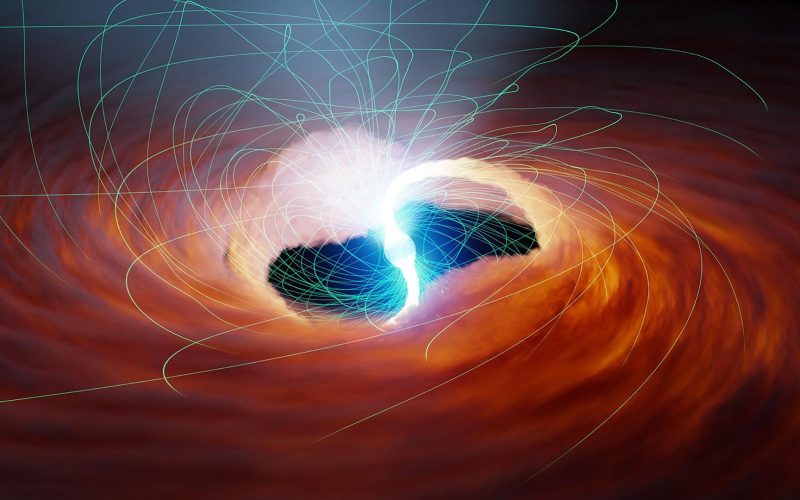Dr. Celeste Nova is a passionate astrophysicist on a mission to bring the wonders of the cosmos closer to everyone. Having spent years unraveling the universe’s mysteries, she enjoys explaining complex scientific concepts in a clear and engaging way. Today, Dr. Nova delves into a captivating story where a celestial event shed light on a revolutionary theory:
The Gravity of the Situation: A Force or a Fabric?
Gravity. It’s the invisible force that keeps our feet firmly planted on the ground, dictates the graceful waltz of planets around the Sun, and even governs the swirling dance of galaxies in the vast cosmic ocean. But for centuries, our understanding of this fundamental force remained rooted in the ideas put forth by Isaac Newton. Newton envisioned gravity as a simple attraction between objects, a concept that dominated scientific thought for a significant period.
Enter Albert Einstein, the brilliant physicist whose mind dared to challenge established notions. In 1915, he unveiled his groundbreaking theory of general relativity. This theory proposed a radical departure from the Newtonian view of gravity. Einstein’s theory suggested that gravity isn’t a force pulling objects together, but rather a warping of spacetime – the very fabric of the universe itself. Imagine a bowling ball placed on a trampoline. The ball creates a dip in the fabric, influencing the movement of smaller objects rolling around it. Similarly, massive objects like the Sun distort spacetime, affecting the paths of anything nearby, including light!
Bending Light: A Bold Prediction
But how could we test this mind-bending idea? Einstein’s theory predicted that a massive object like the Sun would bend the light rays passing close to it. However, this deflection was expected to be incredibly tiny. Measuring such a minute shift under normal circumstances proved impossible.
A Stage for Discovery: The Total Solar Eclipse
This is where a rare celestial event came to the rescue – a total solar eclipse! During a total eclipse, the Moon completely blocks the Sun’s blinding light, creating a temporary veil of darkness. This darkness offers a unique opportunity: it allows us to see the faint stars usually hidden by the Sun’s brilliance. Here’s where things get exciting:
-
The Experiment: In 1919, a team of determined astronomers embarked on expeditions to observe a total solar eclipse. Their mission: to compare the positions of stars near the Sun during the eclipse with their known positions at other times.
-
The Prediction: According to general relativity, the Sun’s gravity should bend the light rays from these stars, causing them to appear slightly shifted compared to their usual locations.

Darkness Reveals the Truth
The results of these expeditions were groundbreaking! Measurements taken by two separate teams, one in Brazil and the other on an island off the coast of Africa, confirmed that starlight did indeed bend around the Sun, precisely as Einstein’s theory predicted.
Key Findings:
| Observation | Before Eclipse | During Eclipse |
|---|---|---|
| Star Positions | Precisely measured | Appear slightly shifted |
| Explanation | Unaffected by Sun’s gravity | Light rays bent by Sun’s gravity |
This wasn’t just a tiny shift; it was a monumental leap forward in our understanding of gravity and the universe itself. The darkness of the eclipse provided the perfect opportunity to observe this unseen phenomenon, solidifying Einstein’s theory as a cornerstone of modern physics.
A Universe of Ripples: Beyond the Eclipse
The story of the eclipse and general relativity isn’t just about a single experiment. It’s a testament to the power of scientific progress and the relentless pursuit of knowledge. Einstein’s theory continues to be tested and confirmed to this day. Since the 1919 eclipse, scientists have observed the bending of light around other massive objects like black holes, further strengthening the power of general relativity. These observations have opened new doors in our understanding of gravity’s influence on the universe’s most extreme environments.
A Legacy of Light from Darkness: Unveiling the Invisible
The story of the eclipse and general relativity is as inspiring as it is ingenious. It reminds us that even the most radical ideas can be validated through careful observation and meticulous experimentation. The darkness of the eclipse provided the stage for revealing an invisible phenomenon, forever changing our understanding of the universe.
This remarkable tale highlights the remarkable synergy between theoretical predictions and observational astronomy. Einstein’s theory, born from pure thought, found its validation in the darkness cast by the Moon. This beautiful interplay between theory and observation continues to drive scientific progress to this day.
Beyond the Eclipse: Unveiling the Cosmos
The implications of general relativity extend far implications of general relativity extend far beyond the bending of light. This theory has become a powerful tool for understanding the grand ballet of the cosmos, from the delicate dance of galaxies to the mind-bending realm of black holes.
Unveiling the Fabric of Spacetime
General relativity paints a picture of a dynamic universe where gravity isn’t a force, but a curvature in spacetime itself. Massive objects like stars and galaxies cause ripples in this fabric, affecting the movement of everything around them. This curvature also influences the passage of time – the closer you are to a massive object, the slower time appears to tick.
The theory has significant ramifications for our understanding of black holes, those celestial beasts with gravity so strong that not even light can escape their grasp. General relativity predicts that the immense gravity of a black hole warps spacetime so severely that it creates a point of no return – the event horizon.
A New Era of Exploration: GPS and Beyond
The applications of general relativity extend beyond theoretical astrophysics. The theory’s understanding of gravity’s effect on spacetime has practical applications that impact our daily lives. For instance, the incredibly precise positioning system we rely on – GPS (Global Positioning System) – needs to account for the warping of spacetime caused by Earth’s mass to deliver accurate location data.
General relativity also plays a crucial role in our understanding of the universe’s expansion. The theory suggests that the expansion of the universe itself is accelerating, a phenomenon attributed to dark energy, a mysterious force about which we still have much to learn.
A Universe of Mysteries: General Relativity and the Unknown
General relativity revolutionized our understanding of gravity, but it’s not the final answer. The theory breaks down under extreme conditions, like the immense gravity near a black hole’s singularity. This points to the need for a more comprehensive theory of gravity, one that can reconcile general relativity with the bizarre world of quantum mechanics, the science that governs the behavior of the universe’s tiniest particles.
The quest for this unified theory of gravity, often referred to as a “theory of everything,” remains one of the biggest challenges in physics today. String theory and loop quantum gravity are some of the leading contenders, each proposing a different framework for understanding the fundamental forces and the nature of spacetime itself.
A Window to the Cosmos: Future Explorations
The story of the eclipse and general relativity is a powerful reminder that the greatest discoveries often emerge from moments of darkness, from venturing beyond the familiar and exploring the unknown. The quest to unravel the mysteries of gravity continues, driven by a new generation of astronomers, physicists, and technologists.
Future space-based telescopes like the James Webb Space Telescope and cutting-edge gravitational wave detectors like LIGO (Laser Interferometer Gravitational-Wave Observatory) are poised to revolutionize our understanding of the cosmos. These powerful instruments will allow us to observe the universe in new ways, potentially leading to groundbreaking discoveries that could reshape our understanding of gravity and the very fabric of reality.
A Call to Curiosity: The Power of Asking Why
The story of the eclipse and general relativity is, at its core, a story about curiosity. It’s about a relentless pursuit of knowledge, a desire to understand the universe and our place within it. It’s a story that should inspire us all to question the world around us, to delve deeper into the mysteries that surround us, and to embrace the wonder of scientific discovery.
So, the next time you witness a celestial event, take a moment to appreciate the awe-inspiring dance of the cosmos. Remember, even the seemingly mundane phenomenon of gravity holds profound secrets waiting to be unveiled. The universe is a vast and wondrous place, and with each new discovery, we gain a deeper appreciation for its beauty and complexity.












